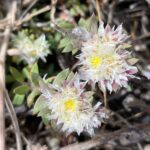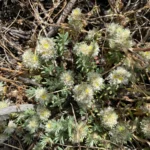Παρονύχια η ασημένια
Etymology of Paronychia argentea
The genus name, Paronychia, originates from the Greek words para [παρά], meaning "by" and onyx [όνυξ], meaning "nail". Botanists chose this name to describe the distinctive appearance of the plant's small, often scale-like or membranous bracts and/or sepals that surround the minute flowers. These structures are frequently arranged in a manner that visually resembles a human fingernail or the cuticle and tissue immediately surrounding the nail. The rigid, often glossy, or translucent nature of these parts further contributes to this "nail-like" impression, applying a term that literally means "beside the nail" to denote this morphological feature.
The specific epithet, argentea, is derived from the Latin word argentum, meaning "silver." This descriptor aptly refers to the silvery, membranous bracts that subtend the small flowers of the plant, giving it a distinctive shimmering appearance. Thus, the full name Paronychia argentea can be understood as "silver-colored plant used for nail ailments."
The Paronychia genus in Cyprus
Three Paronychia species have been recorded so far in the Cypriot habitat.
Paronychia argentea in Cyprus
Paronychia argentea is a relatively unpopular plant in Cyprus, but it is the most common among the three species that exist in Cyprus. It has been recorded all around Cyprus up to an elevation of 1400 meters. In Cyprus, it blooms between December and July.
Key morphological characteristics of Paronychia argentea
Paronychia argentea looks similar to Paronychia macrosepala. Both Paronychia argentea and Paronychia macrosepala are low-growing plants with small flowers, but you can tell them apart by looking closely at their tiny flower parts and their leaves.
Paronychia argentea has very noticeable, shiny silver leaf-like structures (bracts) around its flowers that are longer than the flower's green base (calyx), and its calyx tips are flat with a stiff point. Its leaves are usually smooth or only slightly hairy.
On the other hand, Paronychia macrosepala has less obvious bracts that don't hide the flowers much, and its green calyx parts are larger and don't have the stiff point at the tip. Its leaves are typically more noticeably hairy.




